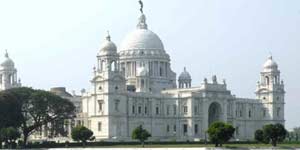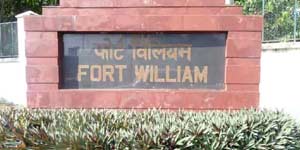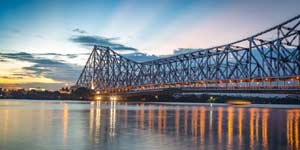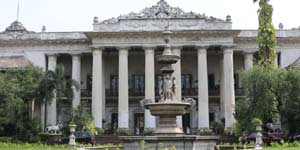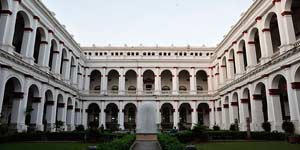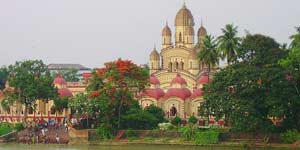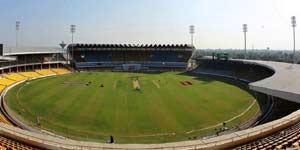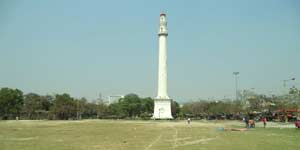
Dakshineswar Kali Temple
Dakshineswar Kali Temple is a Hindu navaratna temple located at Dakshineswar. Situated on the eastern bank of the Hooghly River, the presiding deity of the temple is Bhavatarini, an aspect of Kali,who is form of Adi Shakti Mahalakshmi. The temple was built in 1855 by Rani Rashmoni, a philanthropist and a devotee of Kali. The temple is famous for its association with Ramakrishna, a mystic of 19th Century Bengal.
The temple compound, apart from the nine-spired main temple, contains a large courtyard surrounding the temple, with rooms along the boundary walls. There are twelve shrines dedicated to Shiva—Kali's companion—along the riverfront, a temple to Radha-Krishna, a bathing ghat on the river, a shrine dedicated to Rani Rashmoni. 'Nahabat', the chamber in the northwestern corner just beyond the last of the Shiva temples, is where Ramakrishna and Maa Sarada spent a considerable part of their lives.
Location of Dakshineswar Kali Temple, near Kolkata
Dakshineswar Temple is located at a distance of 20 km north from the central part of Kolkata. It is located alongside the Vivekananda Bridge. The temple admires the eastern bank of River Hooghly.
History of Dakshineswar Kali Temple
In the early phase of 1800s, Dakshineswar was a mere village, which nestled along the eastern bank of the Ganges River. Dense forest surrounded the area. It is said that Rani Rashmoni of Janbazar, while on her pilgrimage to Varanasi, had a dream, where she was instructed to built a Kali temple. Rani Rashmoni was quite a dynamic woman, who was highly respected and adorned by her people. She was intensely moved by the dream and to materialize it, she instructed her people to search for suitable plots to erect the Kali Temple. After a long hunt for land, eventually a 20-acre plot was selected in the village of Dakshineswar. A part of the land belonged to the European Christian, whereas the other part was a Muslim burial ground. In the year 1847AD, under the patronage of Rani Rashmoni, the construction of Dakshineswar Temple was initiated on this very site, signifying the unity of different faiths.
It was decided that the idols of the Gods and the Goddess would be installed on the auspicious day of the ‘snana-yatra’. The temple of Dakshineswar is dedicated to Sri Sri Jagadiswari Kalimata Thakurani. Rani Rashmoni was very benevolent and she wished that pilgrims of all religions and castes would be allowed to offer prayer at the temple. Rani survived only for five years and nine months after the temple was inaugurated. She fell seriously ill in 1861. Realizing that her days are numbered, she handed over a property that she bought at Dinajpur as a legacy for the maintenance of the temple to the temple trust. She passed on 18th February, 1861.
The construction of Dakshineswar temple was initiated in 1847 and it was completed in 1855. The estimated cost of the construction was Rs. 9 Lakhs, of which Rs. 2 Lakhs was spent on the very day of inauguration. The temple along with its abiding areas spans 25 acres of land, which makes Dakshineswar temple one of the biggest temples in Kolkata. The main temple premise is around 46 sq ft. Dakshineswar temple was built in the traditional ‘Nava-ratna’ or nine spires style of Bengal architecture. The roof of the temple spires have been grooved artistically with a striking resemblance with the Pirhas. The temple sports a colossal, elongated structure, resting on a high platform with a flight of stairs. It is a three-story, south-faced temple. The nine spires of the temple are distributed in upper two stories. A narrow covered verandah has been erected, which serves as an audience-chamber and it is attached to the sanctum, which houses the goddess Dakshina Kali. A huge spacious Natmandir (Dancing hall) has been erected in front of the temple.
The Garbha Griha houses the deity of goddess Kali, famously known as Bhavataraini. The idol stands on the chest of Lord Shiva, who rests in a lying posture. The two idols stand beautifully on a thousand-petal lotus, made of silver. This colossal temple of Kali is renowned as one of the rare temples of Indian origin.
This Kali Temple in Dakshineswar is very much associated with Sri Ramakrishna Pramhans, as he was one of the earliest priests of the temple. His room, which nestles at the temple premise, can be accessed by all devotees, who visit the temple.
Tuesdays and Saturdays are believed as auspicious day for Kali worship. On both these days, there is a huge congregation of devotees at the Dakshineswar temple. The Sandhya Aarti is the prime attraction of devotees, which is truly amazing.
Temples of Shiva – The premise of the Dakshineswar temple is admired with twelve identical temples of Shiva. The temples have been erected just opposite to the Kuthi Bari and they nestle close to the banks of River Ganges. The interiors of the Shiva temples are adorned with white and black stone. Each of the temple houses beautiful Shiva Lingas, done in black stone. All these Shiva temples are east facing and they have been erected following the typical ‘Aat Chala’ Bengal architecture. The series of the Shiva temples are divided by Chadni (River bank). Six temples rest at the right of the bank, whereas the other six to the right.
Vishnu Temple – At the north east side of the Dakshineswar temple complex, lies the Vishnu Temple or the Radha Kanta’s Temple. A flight of stairs will lead you inside the temple. The temple houses a 21 and half inches idol of Lord Krishna and 16 inches idol of Radha. It is said that Sri Ramkrishna himself used to perform puja at this temple.
The Panchavati garden, a congregation of five ancient trees, located in close proximity to the Dakshineswar Temple is nicely landscaped and is well maintained by the temple committee. It is said that Sri Ramakriahna used to meditate at this very site.
Monuments in Kolkata
Kolkata, famously known as the ‘City of Joy’, is not just another metro city, but has an important place in the history of India. It was the first capital of the British rulers when they had just started building their system of administration to empower their position in the country. The city has gone through multiple transformations industrially and culturally since its formation. In Kolkata you will find multiple places to tell the story of the British age. Here we discuss five historic places and monuments in Kolkata. Kolkata, which is often called the city of joy is one great destination which is rich in many monuments which reflects the beauty of the glorious past. The city was even a charm during the British rule and it is still a charm. The various monuments available in Kolkata reflect the stories about the city. The beauty of these monuments is unmatched or is rather growing with time. The best monuments in Kolkata is listed here for those who want to check them out when traveling here.


